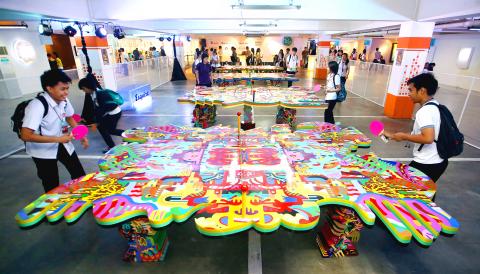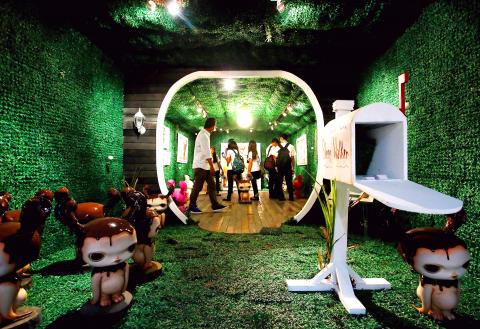Ayala Land Inc Chairman Fernando Zobel de Ayala, Philippine Secretary of Trade and Industry Gregory Domingo and Miss Saigon star Lea Salonga were among the VIPs who prowled a Manila parking garage this week at a preview of Art Fair Philippines.
In its second year, the fair showcasing Philippine contemporary art takes place on two floors of a parking lot in the heart of the Makati financial district. The fair ends today. Compared with regional fairs Art Basel Hong Kong and Singapore’s Art Stage where hundreds of millions of dollars change hands, Art Fair Philippines is a modest event, with only a few million dollars of art for sale, according to the event organizer.
“The upside is you won’t find works of this quality at these prices anywhere in the world,” said Trickie Lopa, co- founder and co-director of the fair.

Photo: EPA
The low prices reflect a local contemporary art scene largely untapped by international collectors, apart from a few artists including Ronald Ventura, whose painting sold for US$1.1 million at Sotheby’s Hong Kong in 2011.
While a handful of works for sale command six figure prices, the majority go for between US$2,000 and US$10,000, said Lopa. “You hardly get any ‘factories’ here, most artists do their own stretching, priming and painting.”
BARGAIN PRICES

Photo: EPA
Paulino and Hetty Que, regarded as the country’s most prominent collectors with hundreds of millions of dollars of works in their home, picked up three paintings, including one by local artist Robert Langenegger for US$2,200.
“Ninety-eight percent of Philippine collectors only buy Philippine art, and 98 percent of the buyers of Philippine art are Filipinos,” says Tina Fernandez, owner of Art Informal gallery in Manila, which sold all 18 works by 31-year-old artist Marina Cruz priced between US$2,000 and US$10,000 at the preview.
Prices of local artists are likely to climb as international galleries start exhibiting their works abroad. Ventura is represented by Galerie Perrotin with spaces in Paris, Hong Kong and New York. Painter and installation artist Geraldine Javier did a four-week residency at the Singapore Tyler Print Institute.
“The progress on the contemporary art scene in the past four years has been incredible,” said gallery owner Matthias Arndt, who sold all 10 works — seven paintings and three sculptures — by local artist Rodel Tapaya during the VIP preview.
IMELDA MARCOS
Tapaya, 33, whose meticulously painted oil-on-canvas works draw heavily on Philippine mythology, now sell for as much as US$120,000, up about 70 percent in two years, said Arndt, whose Berlin gallery is having a one-man show for him next month.
One of the biggest local art collectors of the 1970s and 1980s was Imelda Marcos, wife of former President Ferdinand Marcos, who ruled the country from 1965 to 1986.
In 1973, she bought all 10 paintings at an exhibition of modern master Jaime de Guzman, said Marti Magsanoc, director of Archiva gallery that is selling the artist’s works at the fair for between US$10,000 and US$110,000.
“She used to bring cash in a woven bag,” said Magsanoc, who did not represent de Guzman at the time. “Whether she actually paid for them in this case is not known.”

May 18 to May 24 Pastor Yang Hsu’s (楊煦) congregation was shocked upon seeing the land he chose to build his orphanage. It was surrounded by mountains on three sides, and the only way to access it was to cross a river by foot. The soil was poor due to runoff, and large rocks strewn across the plot prevented much from growing. In addition, there was no running water or electricity. But it was all Yang could afford. He and his Indigenous Atayal wife Lin Feng-ying (林鳳英) had already been caring for 24 orphans in their home, and they were in

On May 2, Chinese Nationalist Party (KMT) Chairman Eric Chu (朱立倫), at a meeting in support of Taipei city councilors at party headquarters, compared President William Lai (賴清德) to Hitler. Chu claimed that unlike any other democracy worldwide in history, no other leader was rooting out opposing parties like Lai and the Democratic Progressive Party (DPP). That his statements are wildly inaccurate was not the point. It was a rallying cry, not a history lesson. This was intentional to provoke the international diplomatic community into a response, which was promptly provided. Both the German and Israeli offices issued statements on Facebook

Even by the standards of Ukraine’s International Legion, which comprises volunteers from over 55 countries, Han has an unusual backstory. Born in Taichung, he grew up in Costa Rica — then one of Taiwan’s diplomatic allies — where a relative worked for the embassy. After attending an American international high school in San Jose, Costa Rica’s capital, Han — who prefers to use only his given name for OPSEC (operations security) reasons — moved to the US in his teens. He attended Penn State University before returning to Taiwan to work in the semiconductor industry in Kaohsiung, where he

Australia’s ABC last week published a piece on the recall campaign. The article emphasized the divisions in Taiwanese society and blamed the recall for worsening them. It quotes a supporter of the Taiwan People’s Party (TPP) as saying “I’m 43 years old, born and raised here, and I’ve never seen the country this divided in my entire life.” Apparently, as an adult, she slept through the post-election violence in 2000 and 2004 by the Chinese Nationalist Party (KMT), the veiled coup threats by the military when Chen Shui-bian (陳水扁) became president, the 2006 Red Shirt protests against him ginned up by